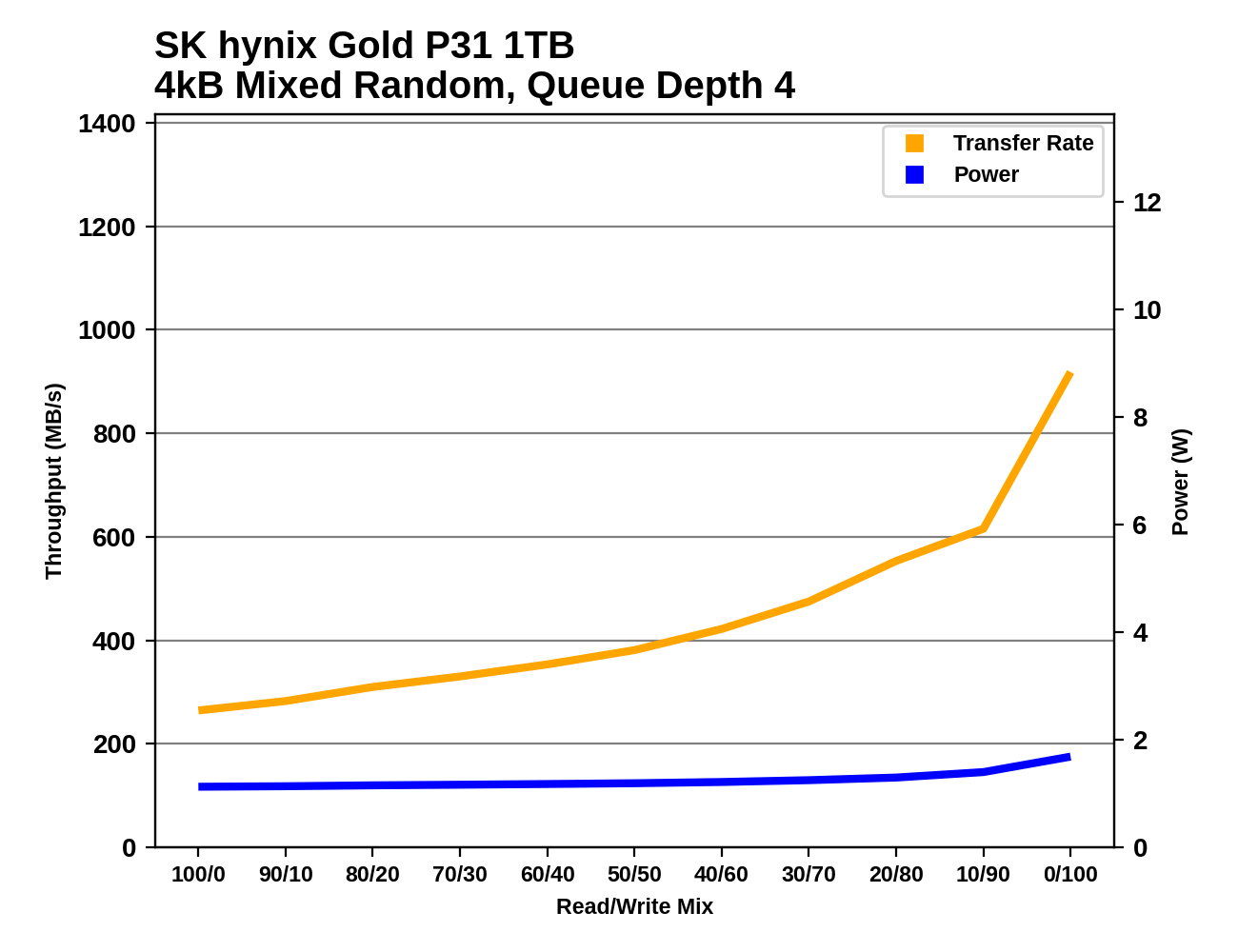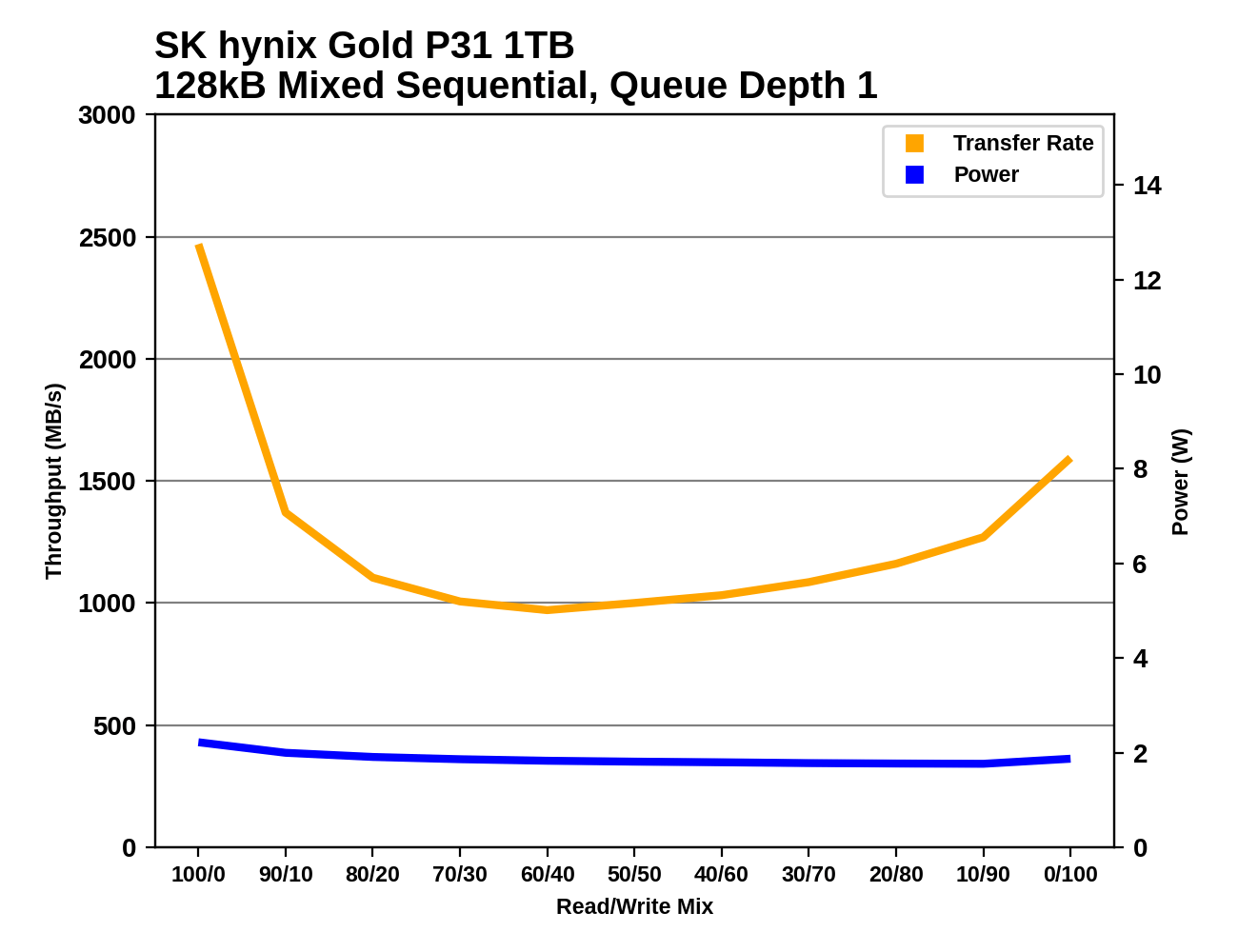The Best NVMe SSD for Laptops and Notebooks: SK hynix Gold P31 1TB SSD Reviewed
by Billy Tallis on August 27, 2020 8:00 AM ESTMixed Random Performance
Our test of mixed random reads and writes covers mixes varying from pure reads to pure writes at 10% increments. Each mix is tested for up to 1 minute or 32GB of data transferred. The test is conducted with a queue depth of 4, and is limited to a 64GB span of the drive. In between each mix, the drive is given idle time of up to one minute so that the overall duty cycle is 50%.

The Intel Optane 905P holds on to a very comfortable performance lead on our mixed random IO test, but the SK hynix Gold P31 raises the bar for TLC-based SSDs by about 10%.
 |
|||||||||
| Power Efficiency in MB/s/W | Average Power in W | ||||||||
The Gold P31 has the lowest average power consumption on this test out of all the drives in this batch, which naturally leads to a massive lead in power efficiency: it delivers twice the performance per Watt of the next best drive.
 |
|||||||||
Compared to other high-end TLC-based SSDs, the Gold P31 performs best during the more read-heavy phases of this test. Several competitors catch up to it and a few surpass it during the most write-intensive portions of the test, but that also tends to be where the P31's power usage advantage is widest.
Mixed Sequential Performance
Our test of mixed sequential reads and writes differs from the mixed random I/O test by performing 128kB sequential accesses rather than 4kB accesses at random locations, and the sequential test is conducted at queue depth 1. The range of mixes tested is the same, and the timing and limits on data transfers are also the same as above.

The mixed sequential read/write performance of the SK hynix Gold P31 is unimpressive. For once, its performance is about what we'd expect from a drive designed more for efficiency than raw performance. However, it still has an 18% lead over the slowest 8-channel drive in this batch.
 |
|||||||||
| Power Efficiency in MB/s/W | Average Power in W | ||||||||
The Gold P31 still completes this test with remarkably low power consumption (averaging less than 2W), but the relatively modest performance means its efficiency score is only about 33% above the next best drive in this bunch.
 |
|||||||||
After starting out with a good sequential read speed, the SK hynix Gold P31's performance drops steeply when writes are added to the mix. It bottoms out just below 1GB/s with a 60% reads mix, and then gradually recovers performance to finish with a fairly typical sequential write speed. Power consumption from the P31 doesn't vary much across the test, and it's only above 2W at the very beginning of the test.










80 Comments
View All Comments
Srikzquest - Thursday, August 27, 2020 - link
Ok thanks Billy. I am going to get this. I have a 960 EVO in my laptop which I will transfer it to my Desktop (which doesn't use an NVMe SSD currently) and replace that with this in my laptop.lmcd - Thursday, August 27, 2020 - link
Good plan -- make sure though that your laptop mobo supports a new enough NVMe version! 960 was one 1.X release earlier.Billy Tallis - Thursday, August 27, 2020 - link
There are very few ways that NVMe could have trouble with forwards compatibility. I don't think any of them apply to features necessary to boot an OS, or to consumer drives in general. Almost all new stuff in recent NVMe versions has been optional features that your motherboard would never need to use, and your operating system can get by without.vladx - Thursday, August 27, 2020 - link
So most of the newer NVME protocols are enterprise only?Billy Tallis - Thursday, August 27, 2020 - link
It's been a mix of enterprise-only features and embedded-only features. Some of the more enterprise-oriented features would be slightly useful on consumer systems, but only in a world where consumers weren't held back by Windows and its lack of good storage admin tools.lmcd - Thursday, August 27, 2020 - link
I guess 99% of laptops are probably fine but I needed a BIOS update for my Lenovo E485 to accept an EVO 970, afaik. Or maybe I'm mixing it up with my desktop motherboard. All I know is that compatibility hasn't been as consistent as you'd expect.Srikzquest - Friday, August 28, 2020 - link
Thanks Imcd for the headsup as my current laptop is also a Lenovo one, T470. So, I will keep my eyes open.MikeMurphy - Friday, August 28, 2020 - link
I think the low power consumption should also help with thermals, though it's a stretch to think of a typical workload that would keep an NVMe SSD under load for very long.Hul8 - Thursday, August 27, 2020 - link
The ADATA XPG SX8200 Pro 1TB is missing from the list of included comparison drives on page 1.I only noticed because I was disappointed by its omission (I have one), but then found it in the graphs anyways.
Billy Tallis - Thursday, August 27, 2020 - link
Thanks for pointing that out. I've added it to the list on page 1.